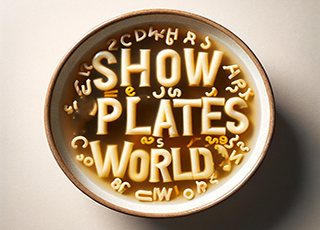Learning the alphabet plays an important role at many stages of a child’s development, because it precedes the goal of children to read and write together. After the child learns the individual letters of the alphabet, then, the children want to know what they meant by numbers and letters. Children always feel bored and tired during the recitation process.
At this point, how should we explain the alphabet to children more creatively and diversely?
One of the ways children learn is through number plates (vehicles’ number plates): Cars, Busses and Trucks Have Number Plates. AB12 CDE / OR 121 FGH 3456.Learning the alphabet while seeing these colourful, varied and visual spells can be a joy for children. In addition, this way they learn vehicles’ names, sometimes unique merging of letters. Also, they see how an individual letter looks.
Learning the alphabet is a lot more fun when you’re creating an alphabet soup with number plates! This is a simple and easy activity you can do at home with your kids or use as a fun ESL activity in the classroom. All you need are paper plates, markers, a bit of string, a few magnets, a large bowl or a bucket and a stick or rod.
Ok now, this is simply fun! Make an alphabet soup with number plates! What a perfect hands-on activity you could do with the kids or use to work on some English Language Skills in the classroom. You will need; paper plates, markers, string, small magnets, one large one, and a long stick or rod.
This could not be any easier. You simply write the letters on the plates. Next, you thread a string through the top of the plate to form a mini garland. Put the last little plate on the large plate and attach the long stick to the front plate. Then simply place them all in a large bowl or bucket and a good stir with the rod and voila, soup!
How to make the Number Plate Alphabet Soup

To make the Number Plate Alphabet Soup, you will need to follow these steps:
Step 1: Cut out 26 paper plates, one for each letter of the alphabet. You can use different colours of paper plates, or you can paint them with different colours. Make sure that the paper plates are big enough to write the letters on them.
Step 2: Write one letter of the alphabet on each paper plate, using a marker. You can use uppercase or lowercase letters, or both. You can also use different fonts or styles, or you can decorate the letters with stickers or glitter. Make sure that the letters are clear and visible on the paper plates.
Step 3: Attach a string to each paper plate, using a hole puncher or a tape. The string should be long enough to hang the paper plate from the stick or the rod. You can use different colours of string, or you can braid or twist them. Make sure that the string is strong and secure on the paper plate.
In Step 4, attach a small and lightweight magnet to the end of each string, using glue or tape. The magnet should be strong enough to hold the paper plate, and you can use different shapes or sizes of magnets or cover them with paper or fabric. Make sure the magnet is securely attached to the string.
In Step 5, fill a large bowl or bucket with water and place it on a stable surface. You can use a plastic tub or cardboard box as an alternative. The bowl or bucket should be big enough to hold all the paper plates, and it should be safe and stable.
In Step 6, submerge the paper plates with letters in the water, making sure they are not tangled or stuck together. You can also add some foam or bubbles to the water or sprinkle some confetti or glitter on the paper plates for extra fun.
Step 7: First, you’ll need to start with a sturdy stick or rod. This could be an actual stick or rod made out of wood or metal, or a stick you create. If you use the latter option, you can tape or glue a piece of paper or fabric to a small wooden or metal rod to pretend that it’s one that has a large enough surface area for a magnet to be connected to. You’ll want your stick to be long enough that you have a good grip, but not so long that it becomes unwieldy.
Next, you’ll attach a magnet to one end of your stick or rod using a tape or glue of some sort. You want to make sure that the magnet is securely connected and won’t fall off or become loose when in use.
How to play the Number Plate Alphabet Soup
To play the Number Plate Alphabet Soup, you will need to follow these rules:
Rule 1: Choose one child to be the fisher, and give them the stick or the rod with the magnet. The rest of the children can be the helpers, and they can sit or stand around the bowl or the bucket. You can also be the fisher or the helper, or you can take turns with the children.
Rule 2: The fisher has to use the stick or the rod with the magnet to ‘fish’ for a paper plate with a letter from the bowl or the bucket. They have to hold the stick or the rod over the water, and try to catch a paper plate with the magnet. They can move the stick or the rod around, but they cannot touch the water or the paper plates with their hands.
Rule 3: When a fisher catches a letter on a paper plate, they must present it to the helpers and recite the letter aloud. They must also utter a vehicle-related term that commences with that letter and mimic the sound of that vehicle. For instance, if they catch the letter “A,” they might say, “A is for ambulance, wee-oo wee-oo,” or if they catch the letter “B,” they might say, “B is for bus, beep beep.” They can also act out the vehicle or draw it on a piece of paper or board to further illustrate their response.
Rule 4: The helpers have to repeat the letter and the word that the fisher says, and clap or cheer for them. They can also help the person fishing to think of a vehicle-related word, or to make the sound or the action of the vehicle. They can also ask the fisher questions about the letter or the word, such as ‘What colour is the ambulance?’, or ‘How many wheels does the bus have?’.
Rule 5: The fisher has to put the paper plate with the letter back in the bowl or the bucket, and mix it well. They can also choose another child to be the next fisher, or they can continue fishing for another letter. The game continues until all the letters have been fished, or until the children get bored or tired.
Why the Number Plate Alphabet Soup is a great activity
The Number Plate Alphabet Soup is a great activity for children, as it can help them to learn the alphabet in a fun and engaging way. Here are some of the benefits of this activity:
- Children will learn to recognise and name the letters of the alphabet, and to associate them with the sounds and the words that they represent. This can improve their phonemic awareness, their vocabulary, and their spelling skills.
- It helps children to learn about different vehicles, and to connect them to the letters and the words that they start with. This can expand their knowledge, their curiosity, and their imagination.
- Children will have the scope to develop their fine motor skills, their hand-eye coordination, and their balance and posture. This can enhance their physical development, their health, and their well-being.
It helps children practice their communication, their listening, and their social skills. This can foster their language development, their confidence, and their relationships.
How to extend the Number Plate Alphabet Soup activity

The Number Plate Alphabet Soup activity is a fun and engaging way to learn the alphabet, but it can also be extended and adapted to suit different ages, abilities, and interests. Here are some ideas on how to extend the activity:
Add more letters and words
To make the activity more challenging, add more letters and more words to both the paper plates and the cards. You can use any combination of five digits and letters, for example, AB34 CDE or FGH 5678. You can change the words to anything car-related such as car, truck, bike or train.
Add more themes and categories
Introducing more themes and categories will ensure that the activity becomes more diverse and creative. You can use different topics that are related to vehicles, such as colours, shapes, sizes, or sounds. You can also use different categories that are related to vehicles, such as animals, fruits, or countries. For example, you can use a paper plate with the letter Z, and say ‘Z is for zebra, a striped animal that looks like a horse’, or ‘Z is for zucchini, a green vegetable that is shaped like a car’.
Add more games and activities
By adding more games and activities, children will find the activity fun and interactive. You can use different types of games and activities, such as puzzles, quizzes, or crafts. For example, you can use a paper plate with the letter P, and make a puzzle with the pieces of a paper plane, or a quiz with questions about planes, or a craft with materials to make a paper plane.
By extending the activity, you can make the Number Plate Alphabet Soup more enjoyable and educational for your children, and help them to learn the alphabet in different ways.
How to spice up the Number Plate Alphabet Soup activity
The Number Plate Alphabet Soup activity is a fun and engaging way to learn the alphabet, but you can also spice it up by adding some variations and twists to the activity. Here are some ideas on how to make the activity more fun and engaging:
Reward the children who fish for the letters and say the words
To make the activity more exciting and motivating, you can give prizes and rewards to the children who complete the activity successfully. Stickers, stamps, certificates, or tokens are some examples of rewards that you can use. You can also keep track of the children’s progress and achievements on a chart or a board.
Make the activity more challenging and competitive
To make the activity more challenging and competitive, you can add some rules and goals for the children who fish for the letters and say the words. For instance, you can set a time limit or a point system for the activity, and use a timer or a scorecard. You can also divide the children into teams, and have them work together and compete against each other.
Surprise and intrigue the children who fish for the letters and say the words
To make the activity more surprising and intriguing, you can add some elements that are unexpected and unknown to the children who fish for the letters and say the words. For example, you can use some special or hidden letters, and have the children say some unusual or exotic words, or some secret or funny words. You can also use some pictures, objects, or toys, and have the children guess what they are.
By adding these variations and twists, you can make the Number Plate Alphabet Soup more fun and engaging for your children, and help them to learn the alphabet in different ways.
Finally
Learning the alphabet is so important for kids, but it’s something that can totally be made fun! And this can be done with: number plates! Make an Alphabet Soup of Number Plates to take the mundane out of learning the alphabet with this fun, playful way to learn letters (and sounds, and words!) while having fun and playing! You really only need some paper plates and a marker. The string and magnets are just for hanging up in our resource area, but can make this a completely easy activity to make and do with your kids at home or with your students in the class or after school program.
Ready to make a Number Plate Alphabet Soup? Your kids will LOVE learning the alphabet!


